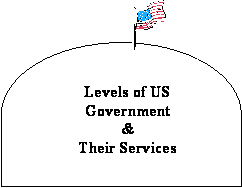| |
Printer-friendly
version
|
Federal (USA) |
Examples of services we receive: military protection, printed money, Postal Service, Space Program (NASA) |
State (MA) |
Examples of services we receive: education, healthcare, housing, government workers, state legislators |
Local (City, town) |
Examples of services we receive: fire station, trash pick-up, public library, teachers |
Tell students: Now that we've talked about the services we receive at the state level of government, let's talk for a minute about the services we receive at the other levels of government.
Ask students if they know what services they receive from the local level of government, in their town or city. If they need assistance, list the services in the appropriate column. Ask them what services they receive from the federal government same with the federal level. Ask for volunteers to tell you or to list the previously discussed state services in the grid. Discuss the services that may be offered at more than one level.
8. Ask students:
What are some of the services you've used? Refer them to the list on the board.
Activity 2
Tell students: I am going to read about situations where people are/may be using government services. Listen closely and identify what government service(s) and/or department(s) the person in the story may be using. You can write your answers down. Use your Massachusetts State Government Departments and Services worksheet to help you.
1. Read the Government Services Scenarios to the class. Read slowly or at a more natural pace, depending on the level. Repeat the scenario as necessary. Give students time to write down their responses to one scenario before you move to the next.
2. Ask for volunteers to offer their responses. Ask the group if they agree or disagree. Encourage verbal elaboration.
Note: This can also be a reading activity. Distribute a copy
of the scenarios to all students. They can work on them together or
in small groups.
Enrichment/extension activities:
Beginning ESOL/Literacy students:
- Distribute the Government Services Guide (pictorial worksheet) to help students in listing services.
- Have students use picture dictionaries, turned to pages depicting services: (police, fire, hospitals, etc) or magazine or other pictures when participating in all activities.
- Cut out the clip art images on the State Government Services Guide and paste them onto index cards. Have students sort the cards into the appropriate departments. Use multi-colored index cards, with each department's services represented by a different color, and students can sort them this way.
- Student can practice sounding out/pronouncing service words to a partner(s) for speaking /listening work.
- Have student write a basic sentence(s) based on a model such as: I need (government service) or I use (government service). A partner or classmate can then practice reading, speaking and pronunciation skills by reporting orally to the class on what his/her partner needs or uses by changing the “I” to “he” or “she”.
Intermediate/higher ESOL, ASE/high ABE/GED students:
- Have students write a paragraph, essay or journal entry: Say: "Thinking about the government service you discussed in Activity 2, what would have happened if that government service weren't available?" Explain.
- Have students use local telephone books and locate government services available in town. What departments offer these services? Students can respond orally or in writing.
- Have students peruse local newspapers for articles/titles about government services. What departments offer these services? Students can respond orally or in writing.
- Have students compare government services offered in their native countries with those offered in Massachusetts. What are the differences? What is the same? Students again can respond orally or in writing.
- Incorporate math into the lessons by having students convert percentages depicted in the Where Does the Money Go? chart into decimals or fractions then practice math operations with them.
- Visit Ben and Jerry’s American Pie: Allocate the Federal Budget. Students can develop their own federal pie budget and compare it to the real one. http://www.benjerry.com:80/americanpie/allocate.cfm
Useful links:
Consider using the following links with students when choosing to have them use the computer as a means for researching services offered through local, state and/or federal governments:
City/town
Local to student
Commonwealth of Massachusetts official website:
http://www.mass.gov
In the search box, type “commonwealth communities”
State of MA
Commonwealth of Massachusetts official website:
http://www.mass.gov
Click the For Residents tab.
Federal
USA.gov:
http://www.usa.gov/index.shtml
»» Your Feedback
We would like to continue to improve and update the curriculum.
Your feedback will help us. Please fill out a form.
Table of Contents | Introduction | Unit 1 | Unit 2 | Unit 3 | Resources
